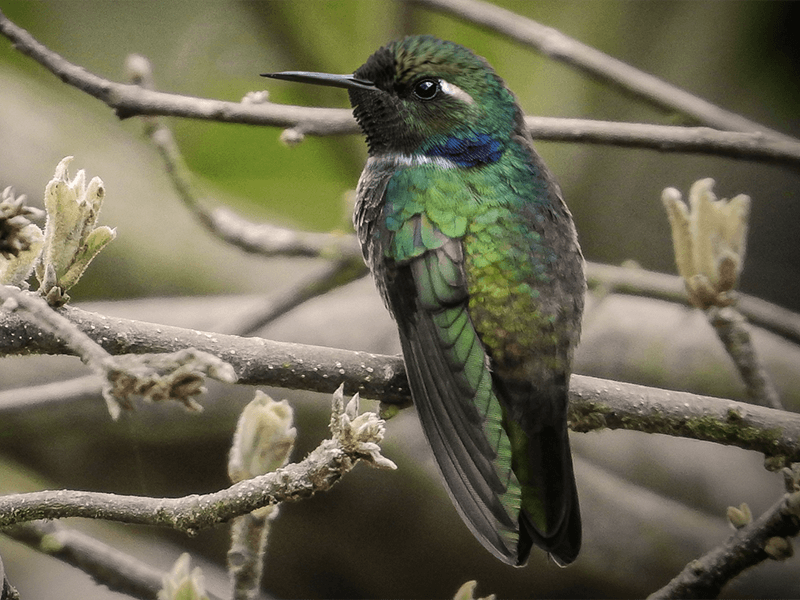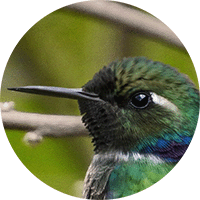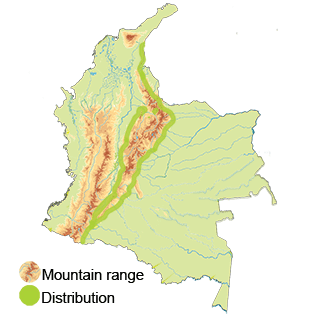Geoffroy's Daggerbill
The Geoffroy's Daggerbill (Schistes geoffroyi) is a fascinating species of hummingbird native to Colombia.
Appearance: Geoffroy's Daggerbill is a striking hummingbird with unique features. It has a long, straight bill that sets it apart from other hummingbird species. The male has bright, iridescent green plumage on its upperparts, a white underbelly, and a dusky green tail. The female exhibits similar colors but with a slightly duller appearance.
Habitat: This species is found in the humid montane forests and cloud forests of the Andes Mountains characterized by high levels of rainfall and moisture, creating ideal conditions for a variety of flowering plants that provide nectar. Cloud forests which are characterized by their frequent immersion in low-level cloud cover at elevations ranging from 1000 to 2500 m above sea level . The cooler temperatures and unique plant communities found at these elevations provide foraging opportunities. These hummingbirds play a crucial role in pollination, making them dependent on habitats with abundant floral resources.
Behavior: The Geoffroy's Daggerbill is known for its aerial acrobatics and agility in flight. It feeds on nectar from flowers using its specialized bill and also catches small insects for protein. These hummingbirds are solitary in nature but may interact aggressively when defending feeding territories.
Breeding: The breeding behavior of Geoffroy's Daggerbill involves courtship displays by the male to attract a mate. The female constructs a small cup-shaped nest made of plant fibers and spider silk, usually placed on a tree branch or shrub. After laying eggs, the female cares for the young until they fledge.
Conservation Status: The
Distribution
Geoffroy's Daggerbill (Schistes geoffroyi) is primarily found in specific regions of Colombia that offer suitable habitat for this hummingbird species. In Colombia, Geoffroy's Daggerbill is mainly distributed in the following regions:
Andean Region: Geoffroy's Daggerbill is commonly found in the Andean region of Colombia, which includes the Andes Mountains and the surrounding areas.
Central Andes: Within the Colombian Andean region, the Central Andes serve as a significant habitat for Geoffroy's Daggerbill. This area includes departments such as Antioquia, Caldas, Risaralda, Quindio, Tolima, and Valle del Cauca, where suitable montane and cloud forest habitats can be found.
Eastern Andes: The Eastern Andes of Colombia also provide important habitat for Geoffroy's Daggerbill. This region includes areas such as Boyacá, Cundinamarca, and Santander, where these hummingbirds can be observed in forested areas at mid to high elevations.
Northern Andes: The Northern Andes of Colombia, encompassing regions like Norte de Santander and Cesar, also offer suitable habitat for Geoffroy's Daggerbill. These areas provide a range of elevations and forest types that support the species' feeding and breeding behaviors.
Protected Areas: Geoffroy's Daggerbill may also be found in various protected areas and national parks across Colombia that aim to conserve biodiversity and provide safe havens for wildlife. These protected areas within the Andean region serve as important refuges for the species.
Taxonomy
The Geoffroy's Daggerbill (Schistes geoffroyi)
- Kingdom: Animalia
- Phylum: Chordata
- Class: Aves (Birds)
- Order: Caprimulgiformes
- Family: Trochilidae
- Genus: Schistes
- Species: Schistes geoffroyi
Vocalization
The vocalizations of Geoffroy's Daggerbill hummingbird (Schistes geoffroyi) play an important role in communication, territorial defense, and mate attraction.
- Chirps and Calls: Geoffroy's Daggerbill produces short, high-pitched chirps and calls that are often used during territorial displays or interactions with other individuals. These chirps can vary in intensity and frequency, depending on the context.
- Buzzing Sounds: In addition to chirps, Geoffroy's Daggerbill may also emit buzzing sounds during flight displays or aggressive encounters. These buzzing sounds are produced by the rapid movement of their wings and serve as a form of acoustic signaling.
- Whistles: Some descriptions of the vocalization of Geoffroy's Daggerbill mention soft whistling sounds that they may use in certain situations, such as courtship displays or while interacting with mates.
- Soft Vocalizations: While not as loud or elaborate as the vocalizations of some other hummingbird species, the vocal repertoire of Geoffroy's Daggerbill includes soft and subtle sounds that are characteristic of this species.





